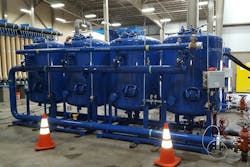Filter Media Helps Oxidize Manganese for Easy Removal
Manganese is a naturally occurring contaminant in surface and groundwater that can cause issues with water systems and affect health. Typical manganese treatment includes adding permanganate as a stronger oxidant than chlorine, use of a 30-minute-minimum contact or reaction basin, and then filtration at 3 gal per minute (gpm) per sq ft or less surface loading rate.
Watersurplus’ OxiPlus75 catalytic filter media helps oxidize manganese for easy removal during filtration without permanganate or the need of a contact basin. Normally manganese takes 30 to 90 minutes to oxidize to the insoluble form in the presence of residual chlorine; with the oxidation catalyst filter media, the oxidation time is reduced to 10 to 30 seconds. The ability to remove the manganese to lower levels after treatment with surface loading rates that are 2 to 3 times higher than traditional methods is a secondary benefit. This means the treatment equipment has a small footprint, saving building space and reducing the capital costs of the full treatment installation.
OxiPlus75 has a typical manganese dioxide content of 75%, which is the source of this catalytic property. An NSF 61 certification on this product ensures that it is safe to use in potable water applications or prior to reverse osmosis systems to reduce membrane fouling. In one treatment process, it is possible to remove other contaminants, including arsenic, iron, radium and hydrogen sulfide.
